A quick guide to EN Standards
All protective clothing needs to conform to certain EN (European Norms) safety standards to protect workers who are employed in a high-risk or hazardous environment. Anyone who works on a public highway, in a high fire or flame risk situation, will need specialist clothing to keep them as safe as possible.
EN Standards can be very confusing, so you need to know what to look for. First of all, if you need specialist work clothing or protective clothing for those at risk, you need to look very carefully at what you're buying and who you're buying it from. Flame retardant clothing is a pretty niche market and you need to buy from someone who knows what they are talking about. The term fire retardant as applied to organic (i.e. containing carbon) materials, might be better referred to as reduced fire hazard, as all will burn under certain circumstances.
You will see all sorts of symbols and codes written on labels, so which is correct? Well, the answer to that is that a lot of them may be correct as standards have changed. This does not mean that the old standard was incorrect, it simply means that the new standards will make clothing even safer.
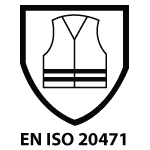
EN ISO 20471:2013 - HIGH VISIBILITY
The new International Standard for High Visibility Clothing is due to be published in the Official Journal of the EU in 2013. Summary of the main updates to the new EN ISO 20471 standard:
- 1. Class 1 Retro-reflective tape is no longer an option so only Class 2 Retroreflective tape is permissible.
- 2.The EN ISO 20471 symbol has been updated.
- 3. Placement of retro-reflective tape - The mandatory patterns for retroreflective tape remain unchanged, except now additional bands of tape may be added to achieve required areas.
- 4. Class 3 garments must now be garments, which cover the torso and have either full-length sleeves or full-length legs.
- 5. Fluorescent background materials must pass colour and luminance tests after the stated number of washes on the care label. (not applicable to vests and tabards).
- 6. Tensile strength, Burst strength and Tear strength requirements have been reduced.
- 7. Colourfastness to perspiration staining requirement has increased to 4.
- 8. Colourfastness to washing/dry cleaning staining requirement has been reduced to 4 for non-fluorescent fabrics.
- 9. Water vapour permeability requirements for fabrics (excluding EN343 fabrics) have been amended.
- 10. Retro- Reflective Tape: Performance after washing test method requires each cycle to be a wash and dry cycle. EN471 only requires drying after the last wash cycle.
EN ISO 20471 Performance parameter:
X - Surface of fluorescent and retro-reflective material (3 levels).
Class 3: Highest Level
Highest level of protection - required for any persons working on or near motorways or dual-carriageways or airports. Must incorporate a minimum of 0.80m² of background material and 0.20m² of retro-reflective materials. (4 metres of 5cm wide reflective tape).
Class 2: Intermediate Level
Required for any persons working on or near A and B class roads, also for delivery drivers. Must incorporate a minimum of 0.50m² of background material and 0.13m² of retro-reflective material. (2.60 metres of 5cm wide reflective tape).
Class 1: Minimum Level
Minimum level of protection required for any persons working on a private road or to be used in conjunction with a higher classed garment. Must incorporate a minimum of 0.14m² of background material and 0.10m² of retro-reflective material. (2 metres of 5cm wide reflective tape).
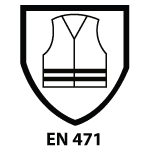
EN 471:2003 - HIGH VISIBILITY
This is the European standard for high visibility clothing. It states that those operating in hazardous situations must be visible in any light conditions, day or night. The standard provides for two performance parameters:
X - Surface of fluorescent and retro-reflective material (3 levels)
Y - Quality of the retro-reflecting materials (2 levels)
Class 3: Highest Level
This describes the highest level of protection, required for those working on or near motorways, dual-carriageways or airports. The clothing must feature at least 0.80m² of fluorescent background material and 0.20m² of retro-reflective materials. (4 meters of 5cm wide reflective tape)
Class 2: Intermediate Level
This level of protection is necessary for those working on or near A and B class roads and for delivery drivers. The clothing must feature at least 0.50m² of fluorescent background material and 0.13m² of retro-reflective material. (2.60 metres of 5cm wide reflective tape)
Class 1: Minimum Level
This level of protection is relevant for those working on a private road, or to be used alongside class 2 or 3 high visibility garments. The clothing must feature at least 0.14m² of fluorescent background material and 0.10m² of retro-reflective material.
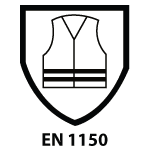
EN 1150 Protective clothing
Visibility clothing for non-professional use
Test methods and requirements
This Standard specifies the optical performance requirements for high visibility clothing to be worn by adults and by juveniles and designed for non-professional use. High-visibility clothing for non-professional use is intended to signal the user's presence visually in any daylight condition and, when illuminated by vehicle headlights or searchlights in the dark as well as lit up on urban roads. This standard is not applicable to accessories to be carried by persons or attached to garments.

EN 342
EN 342 standard for protective clothing - Ensembles and garments for protection against cold. This is the European standard for protective clothing used in foul weather, wind and cold conditions above -5 °c. There are two performance parameters:
- X - 3 levels of waterproofness
- Y - 3 levels of breathable properties
- A - Thermal insulation, measured value
- B - Air permeability class (1 - 3 where is best)
- C - Resistance to water penetration class (optional) (1-2 where 2 is best)
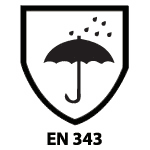
EN 343 - PROTECTION AGAINST RAIN
Protective clothing certified according to EN 343 protects against precipitation such as rain or snow, fog and ground humidity. The garment and the seams are tested for their water resistance, but also water vapour resistivity.
The garment is classified according to water-resistant properties, and the water vapour resistivity gives the recommended working time.
X: Resistance to water penetration ( max 3 levels)
Y: Water vapour resistance - Breathing properties (3 levels)
Resistance to water penetration is the most important quality for adequate protection. The resistance to water penetration is expressed in kPa but a more understandable expression is in millimetre water column.
The classic and easy-to-understand unity for breathability was defined in g/m² per 24 hours. However, EN 343 uses a water vapour resistance value Ret (m². Pa/W), which is measured by the 'so-called' skin model test ISO 11092. For a clear understanding the higher the Ret value, the higher the resistance of the fabric, and the less vapour passes through in these particular lab conditions (static, ISO temperature 35 В°C).
Breathable garments evacuate the perspiration away from the skin and from the garments. When too much humidity has accumulated in the clothing, condensation occurs and the skin feels clammy.
In cold atmospheric circumstances one risks cooling down too quickly; otherwise, in warm circumstances, the rhythm of the heart will increase and after some time there is a risk of heat stress.
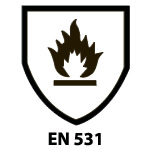
EN 531:1995
The European Standard for protective clothing for those working in an environment where they may be exposed to heat (excluding clothing for firefighters and welders)
Performance levels are stated by the following categorisation:
- Code A: Limited flame spread
- Code B: Protection against convective heat
- Code C: Protection against radiant heat
EN 531:1995
Dimensional change:
- Code A: Limited Flame Spread
- Code B: Protection against Convective Heat
- Code C: Protection against Radiant Heat
- Code D: Protection against Molten Aluminium Splash
- Code E: Protection against Molten Iron Splash
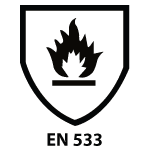
EN 533
The European Standard for protective clothing provides protection against heat and flame. It applies to clothing which has limited flame spread materials and assemblies.
EN 533-1:1997
Limited flame spread.
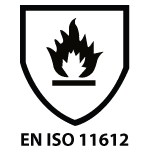
EN ISO 11612
The performance requirements set out in this international standard are applicable to garments which could be worn for a wide range of end uses, where there EN ISO 11612 is a need for clothing with limited flame spread properties and where the user can be exposed to radiant or convective or contact heat or molten metal splashes.
- Code A: Limited flame spread
- Code B: Protection against Convective Heat-3 levels
- Code C: Protection against Radiant Heat - 4 levels
- Code D: Protection against Molten Aluminium Splash - 3 levels
- Code E: Protection against Molten Iron Splash - 3 levels
- Code F: Protection against Contact Heat В· 3 levels
EN ISO 11612:2008
Dimensional change
- Code A1 & A2: Limited Flame Spread
- Code B: Protection against Convective heat
- Code C: Protection against Radiant Heat
- Code D: Protection against Molten Aluminium Splash
- Code E: Protection against Molten Iron Splash
- Code F: Protection against Contact heat
- Heat Resistance
- Tensile strength
- Tear strength
- Busting strength
- Seam strength.
The Railway Group Standard gives the minimum requirements for high visibility clothing worn by Rail Industry workers. Until recently the safety standard for Fireproof protective clothing was EN531. This has now been replaced by EN ISO 11612 - Protective Clothing for Heat and Flame.
So, what is the new standard for? Well, the new standard not only tests the fabric used to produce the clothing, but it also tests the whole fireproof garment. This is to stop an influx of sub-standard flameproof protective clothing flooding the market.
The new standard will ensure that the wearer will have greater confidence that the specialist flameproof garment that he or she is wearing offers proper protection. Previously there was a real danger that some manufacturers were simply buying fabric that came up to EN 531 standards, but then making cheap clothing, by using non-fireproof thread, fasteners and zips etc. This meant they were actually meeting the standards set, but the garment as a whole was not tested, just the fabric. The new standard EN ISO 11612 will ensure the whole garment is up to scratch.
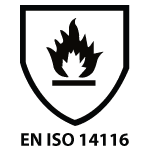
EN ISO 14116
This standard details the limited flame spread properties of materials, material assemblies and protective clothing to reduce the chances of clothing burning and constituting a hazard.
EN ISO 14116:2008
- Limited Flame Spread
- Tensile Strength
- Tear Strength
- Seam Strength
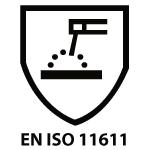
EN ISO 11611
This is an International Standard stating the minimum basic safety requirements and the test methods required for protective clothing for use in welding and allied processes (excluding hand protection).
Two classes of performance requirements are specified:
Class 1: is protection against less hazardous welding techniques and situations, causing lower levels of spatter and radiant heat.
Class 2: is protection against more hazardous welding techniques and situations, causing higher levels of spatter and radiant heat.
EN ISO 11611:2007
- Tensile Strength
- Tear strength
- Busting strength
- Seam strength
- Dimensional change
- Requirements of leather
- Limited Flame Spread (A 1 + A2)
- Molten Droplets
- Heat Transfer (radiation)
- Electrical resistance
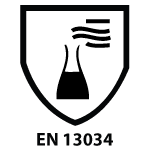
EN 13034:2005 + A1:2009 Protective Clothing against Liquid Chemicals
This standard states the performance requirements for chemical protective clothing offering limited protective performance against liquid chemicals (Type 6 and Type PB [6] equipment). It specifies the minimum requirements for limited use and reusable limited performance chemical protective clothing. Limited performance chemical protective clothing is intended for use in cases of potential exposure to a light spray, liquid aerosols or low pressure, low volume splashes, against which a complete liquid permeation barrier (at a molecular level) is not required.
The standard covers both chemical protective suits (Type 6) and partial body protection (Type PB [6]). Chemical Protective suits (Type 6) cover and protect at least the trunk and the limbs, e.g. one-piece coveralls or two-piece suits, with or without hood, boot-socks or boot covers. Partial body protection of similar limited performance (Type PB [6] covers and protects only specific parts of the body, e.g. coats, aprons, sleeves, etc.)

EN 374-2:2003
This standard applies to disposable gloves tested for protection against liquid penetration and micro-organisms.
| Performance Level | Time Passed Before Chemical Breakthrough (Minutes) |
| Level 1 | >10 minutes |
| Level 2 | >30 minutes |
| Level 3 | >60 minutes |
| Level 4 | >120 minutes |
| Level 5 | >240 minute |

EN 149
The European Standard for the testing and protection levels offered by filtering face masks.
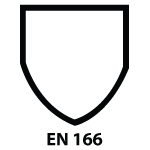
EN 166
This European Standard applies to personal eye protection and tests for impact, optical quality, chemical, dust and molten metal protection.
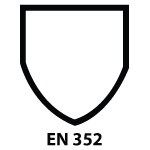
EN 352
The European Standard for the testing of ear defenders and ear plugs. It states that persons working in noise levels between 80dBA and 85dBA must be provided with suitable hearing protection on request. For those working at or above 85dBA suitable hearing protection must be supplied and worn.

EN 388
The European Standard for gloves protecting against mechanical risks. In accordance with EN 388:2004, all tests and results are performed from the palm area of the glove material and on the material combination used in the glove. The gloves are specially designed to protect the hands from mechanical injuries.
A tested item is given a performance rating of 1 to 4 (lowest to highest) on some or all of the listed categories. The 'blade cut resistance' test is an exception as it measures from 1 to 5.
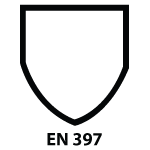
EN 397
The European Standard covering industrial safety helmets. It provides specifications for shock absorption, resistance to penetration, resistance to flame and chin strap anchorage. It also advises that the shelf life of helmets is 5 years from the date of manufacture.
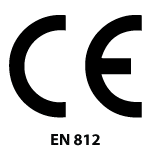
EN 812
The European Standard specifies the physical and performance requirements, methods of test and marking requirements for industrial bump caps.
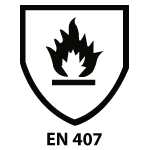
EN 407
European Standard for gloves protecting against thermal risks.
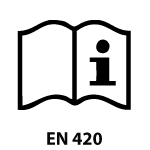
EN 420
The European Standard for safety hand wear, defining the general requirements for features such as glove design and construction.
This standard defines the general requirements and relevant test procedures for all protective gloves and is concerned with the following areas:
- Glove design and construction
- resistance of gloves materials to water penetration
- innocuousness, comfort and efficiency
Please note that the standard does not address the protective qualities of the gloves and so is designed to be used in conjunction with the appropriate specific European Standard.

EN 455
This standard applies to medical gloves for single use, establishing their strength and protection properties.
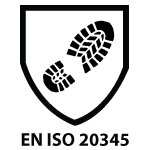
EN ISO 20345
This European Standard identifies the protection offered by safety footwear. It has a comprehensive classification system designed to describe the various protection offered, such as the presence of a safety toecap, penetration resistance, anti-static properties and water resistance.

EN 13287
This European Standard tests the slip resistance of safety, protective and occupational footwear.
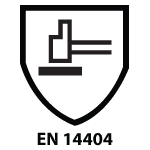
EN 14404
The European Standard for knee protectors for use in a kneeling position. It describes the test methods and specifies the performance levels.
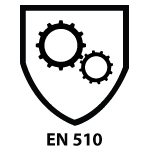
EN 510
PPE risk of entanglement with moving parts. EN510 Specification for protective clothing for use where there is a risk of entanglement with moving parts.
This standard specifies the properties of protective clothing that reduce the risk of entanglement or entanglement in moving machinery when the wearer is working on or near machinery or equipment in hazardous movement. This standard does not apply to protective clothing against injury by special machine parts in motion for which there is a specific standard, such as protective clothing for users of chainsaws.
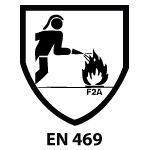
EN 469
This European Standard specifies minimum levels of performance requirements for protective clothing to be worn during firefighting operations and associated activities. Suits shall provide protection for the firefighter's torso, neck, arms to the wrists, and leg to ankles during firefighting activities. A generous overlap suitable for all body movements shall be maintained between the jacket and trousers. EN469:2006 Level 2 Fire Suits
EN469:2006
- Flame Spread
- Heat Transfer (Flame)
- Heat Transfer (Radiation)
- Residual Strength
- Heat Resistance
- Tensile Strength
- Tear Strength
- Surface Wetting
- Dimensional Change
- Resistance to penetration by Liquid Chemicals
- Resistance to Water Penetration
- Water Vapour Resistance
- Ergonomic Requirements
- Visibility - Reflex
- Whole Garment Testing (Optional)
Explaining the standard
EN469:2006 Level 2 Fire Suits is the higher requirement for structural fire fighting and is used by professional trained firefighters.
Level 2 Suits must include a waterproof moisture barrier. All Level 2 Fire Suits will be marked internally as follows:
- Xf2 Level2 - Performance in Heat Test: Flame
- Xr2 Level2 - Performance in Heat Test: Radiation
- Y2 Level2 - Resistance against Water Penetration
- Z2 Level2 - Resistance against Water Vapour Resistance
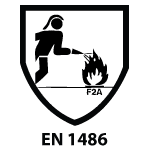
EN 1486
This European Standard specifies test methods and minimum performance requirements for reflective protective clothing used in specialised fire-fighting.
This clothing provides protection against flame lick and intense radiant heat and is worn for short periods only, to enable the fire-fighter to enter specific high-risk fire-fighting and fire rescue situations which also require the use of breathing apparatus.
This standard only covers protective clothing that relies upon the ability of the outer material to reflect intense heat. This type of reflective clothing may also be used for industrial applications involving high levels of radiant heat.
EN 1486:2007
- Flame Spread
- Heat Transfer (Radiation)
- Heat Transfer (Convective)
- Contact Heat
- Heat Resistance
- Dimensional Change
- Tensile Strength
- Burst Strength
- Tear Strength
- Seam Strength
- Surface Wetting
- Whole Garment Testing (Optional)

EN 15614
This European Standard specifies methods of test and minimum performance requirements for protective clothing, designed to protect the wearer's body, except the head, hands and feet, to be worn in wildland firefighting and associated activities. This clothing is not intended to provide protection during fire entrapment.
This European Standard covers the general design of the clothing, the minimum level of performance for the materials employed and the methods of test to determine these levels.
This European standard is not applicable to clothing for use in situations encountered in structural firefighting (EN 469 and ISO 11613) or where a high level of radiant heat is expected (EN 1486), nor does this European Standard cover clothing to protect against chemical, biological or radiation hazards.
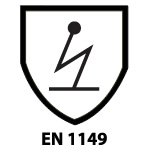
EN 1149:2008
This is the European Standard for clothing designed to protect against the danger of static electricity. It is not applicable for protection against mains voltage.
EN 1149-1:1996 Test method for surface conducting fabrics
EN 1149-3:2004 Charge decay test method for all fabrics
EN 1149-5:2008 Performance requirements
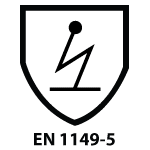
EN 1149-5
EN 1149-5:2008 is the harmonised European standard for protective clothing protection against the danger caused by static electricity. This standard is not applicable for EN 1149 protection against mains voltages.
- EN 1149-1:1996 Test method for surface conducting fabrics.
- EN 1149-3:2004 Charge decay test method for all fabrics.
- EN 1149-5:2008 Performance requirements.
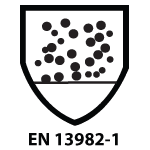
EN 13982-1
Protective clothing for use against solid particulates.
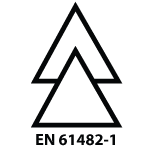
EN 61482-1
Protective clothing certified according to EN 61482-1 protects the wearer against the hazards of an electric arc.
Open Arc Method EN61482-1-1
TESTED USING METHOD A - FABRIC ONLY. The ATPV (Arc Thermal Protection Value) result (expressed in cal/cm2} represents the maximum incident thermal energy in units of energy per square area that fabric can support before the wearer will suffer 2nd-degree burns. This method tests the fabric with an 8 kA arc for various incident durations. Workers are assumed to be safe if the arc rating of their clothes exceeds the electric arc incident energy calculated in the worst-case scenario of a risk assessment. Garments can be layered to achieve an overall ATPV Rating. For example, thermals may achieve an ATPV of 4.3 Cal/m2, and an outer coverall may achieve an ATPV of 13.6Cal/cm2. However, the combination ATPV will be greater than the sum of the two single layers, as the air gap between the two layers affords the wearer additional protection.
ASTMF 1 959/F1 959M-12
FABRIC ONLY TEST. This test method is the same as outlined above under EN 61 482-1-1. Pre-treatment may vary.
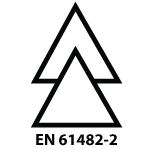
EN 61482-2:2007/IEC61482:2009
This standard investigates the fabric and garments' ability to protect against the thermal effects of an electric arc event. This can be done via two test methods:
Box Test Method EN 61482-1-2
The fabric/garment is exposed to an electric arc confined in a specific box with a specific electrode arrangement for 0.5 seconds. Class 1 is to a current of 4 kA arc, Class 2 is to a current of 7 kA arc. Test conditions for class 1 & 2 try to simulate typical exposure conditions for a short circuit current of 4 kA and 7 kA respectively.
Open Arc Method EN 61482-1-1
The ATPV result (expressed in cal/cm2) represents the maximum incident thermal energy in units of energy per square area that fabric can support before the wearer will suffer 2nd-degree burns.
This method tests the fabric with an 8 kA arc for various incident durations.
Workers are assumed to be safe if the arc rating of their clothes exceeds the electric arc incident energy calculated in the worst-case scenario of a risk assessment.
Garments can be layered to achieve an overall ATPV Rating. For example, Thermals may achieve an ATPV of 4.3 Cal/m², and an outer coverall may achieve an ATPV of 13.6 Cal/cm. However, the combination ATPV will be greater than the sum of the two single layers, as the air gap between the two layers affords the wearer additional protection.

RIS-3279-TOM (GO/RT 3279) - RAIL INDUSTRY STANDARD
This is the International Standard setting out the performance requirements for garments with limited flame spread properties, which may be worn for a variety of end uses, or where the user may be exposed to radiant, convective or contact heat or molten metal splashes.
Code A: Limited flame spread
Code B: Protection against Convective Heat - 3 levels
Code C: Protection against Radiant Heat - 4 levels
Code D: Protection against Molten Aluminium Splash - 3 levels
Code E: Protection against Molten Iron Splash - 3 levels
Code F: Protection against Contact Heat - 3 levels

GOST-R
OBLIGATORY CERTIFICATE
Certifies quality of actually supplied goods and their compliance with contractual terms. A quality certificate contains a profile of goods or confirms their compliance with certain standards or specifications of a delivery order. A certificate of compliance is intended for the certification of goods produced by Russian companies or shipped to Russia by an importer company. A certificate of compliance can be issued for a batch of goods and on a series production. In the former case, a certificate is legalised for a company engaged in supplying goods to the Russian market. Its validity varies with the terms of a sale contract. In the latter case, a foreign manufacturer of supplied goods is both an applicant and a recipient of a certificate. This type of certificate is valid for a period identified in a certification document. Certification is carried out by our specialists on the production premises of a company seeking certification of goods it manufactures. On the basis of results obtained during testing samples of goods in a laboratory an appropriate certificate of series production compliance is issued.
There are cases where a GOST certificate is issued when documents like a hygienic report, a veterinary certificate, fire safety certificate, etc. are available. This all means that we must receive all these documents for you before.
VOLUNTARY CERTIFICATE
For products not subjected to mandatory certification according to Russian law, a voluntary certification scheme may be applied. Exporters or importers initiate voluntary certification with the aim to formally prove the conformity of their products to the applicable Russian standards, technical norms or recipes. In other words, the GOST Certificate of Conformity is a powerful marketing tool to capture Russian customers.
